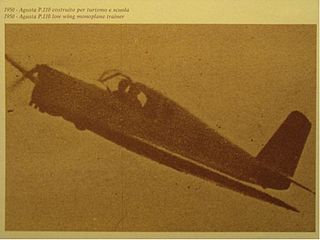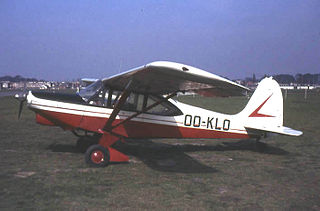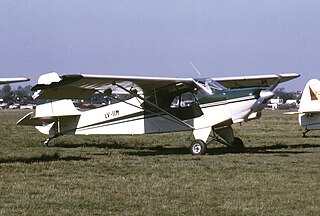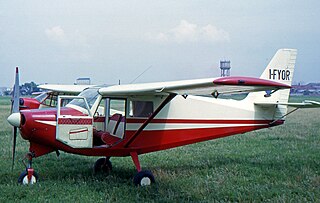
The Falco F8L is an Italian-designed lightweight 2-seater aerobatic aircraft.

The Aero Commander 100, various models of which were known as the Darter Commander and Lark Commander, is an American light aircraft produced in the 1960s. It was a high-wing monoplane of conventional design, equipped with fixed tricycle undercarriage.

The PA-25 Pawnee is an agricultural aircraft produced by Piper Aircraft between 1959 and 1981. It remains a widely used aircraft in agricultural spraying and is also used as a tow plane, or tug, for launching gliders or for towing banners. In 1988, the design rights and support responsibility were sold to Latino Americana de Aviación of Argentina.

The Agusta CP-110, also known as CVV P.110 or Politecnico P.110, was a prototype Italian four-seat light aircraft first flown in 1951 that failed to attract interest from either civil or military operators, although it was evaluated by the Aeronautica Militare. Originally designed and built by the CVV -, production aircraft were to have been built by Agusta, but for lack of interest.

The Boisavia B.60 Mercurey was a series of four-seat light aircraft developed in France shortly after World War II.

The Pützer Elster was a German single-engined light aircraft, manufactured by Alfons Pützer KG in Bonn. It served with the Luftwaffe and Marineflieger and was used solely for recreational sport flying. Some continue to fly in 2020 in private ownership.

The DINFIA IA 46 Ranquel, IA 46 Super Ranquel, and IA 51 Tehuelche were Argentine utility aircraft developed in the late 1950s.

The Hoffmann H40 was a prototype sport aircraft built in Germany in 1988. Designed by Wolf Hoffmann based on his Dimona motor-glider, it was a conventional, low-wing monoplane with side-by-side seating for two and tricycle undercarriage. The aircraft's high aspect ratio wings and T-tail were carried over from its motorglider heritage, but the span was shorter than that of the Dimona. Construction throughout was of composite materials. Hoffmann intended this aircraft to compete with sporting two-seaters such as the Grob G 115 and Robin ATL, but was unable to find the financial backing to bring the aircraft to market, despite a 30% share bought in the project by German pump manufacturer ABS.

The IAR-824 was a utility aircraft built in Romania in the 1970s.

The Partenavia P.57 Fachiro is an Italian, four-seat, high-wing, touring monoplane, fitted with a fixed tricycle undercarriage.

The Maule M-7 is a family of single-engine light aircraft that has been manufactured in the United States since the mid-1980s.

The GY-80 Horizon is a French four-seat touring monoplane of the 1960s designed by Yves Gardan and built under licence, first by Sud Aviation, and later by that company's SOCATA subsidiary.

The Piel CP.70 Beryl is a French twin-seat, single-engine sport aircraft designed by Claude Piel. It was first flown in France in the 1960s and marketed for amateur construction.

The Varga 2150 Kachina is an American all-metal, low-wing, fixed-gear, two-seat light aircraft fitted with a tricycle undercarriage.

The Ambrosini Rondone is an Italian-designed two/three-seat light touring monoplane of the early 1950s.

The Dyn'Aéro CR.100 is a French kit built single engine, two-seat monoplane, developed in the 1990s and intended as both an aerobatic trainer and a tourer, primarily for aero club use.

The B&F Fk9, also marketed as the FK-Lightplanes FK9, is a German-designed single-engine, two-seat ultralight, first flown in 1989. It has been developed from a mixed structure, fabric covered aircraft to a wholly composite machine. It remains in production at factories in Germany and Poland and has sold in large numbers, flying on four continents.

The Aeronca K series, Aeronca Chief, Aeronca Super Chief, Aeronca Tandem, Aeronca Scout, Aeronca Sea Scout, Aeronca Champion and Aeronca Defender were a family of American high-winged light touring aircraft, designed and built starting in the late 1930s by Aeronca Aircraft.

The Aviamilano F.14 Nibbio is a four-seat, single engine cabin monoplane built in Italy in the late 1950s. Only ten production aircraft were completed.

The Rubik R-18 Kánya is a Hungarian light utility and glider tug aircraft. It was designed by Ernő Rubik, the father of the designer of the Rubik's Cube.




















